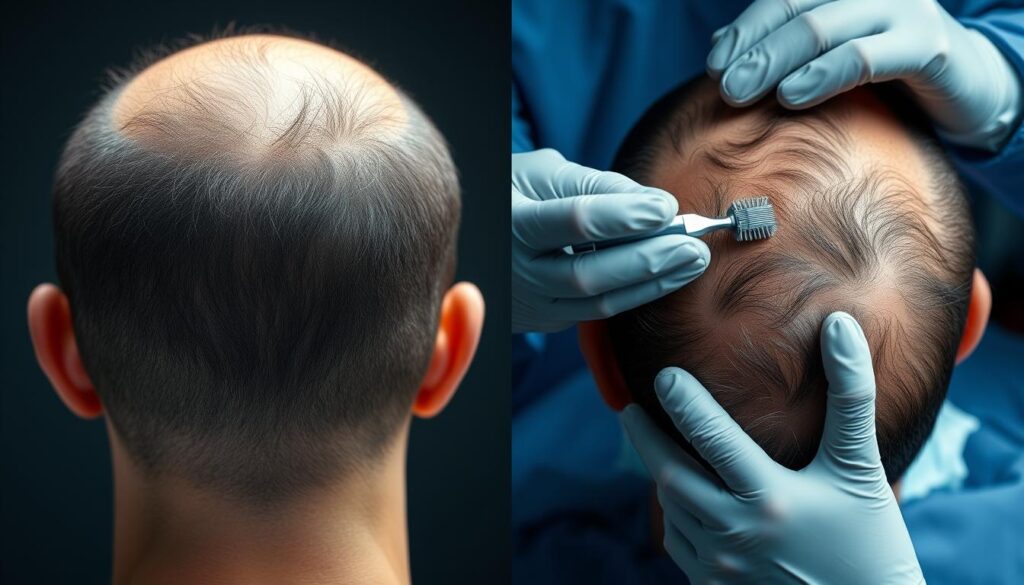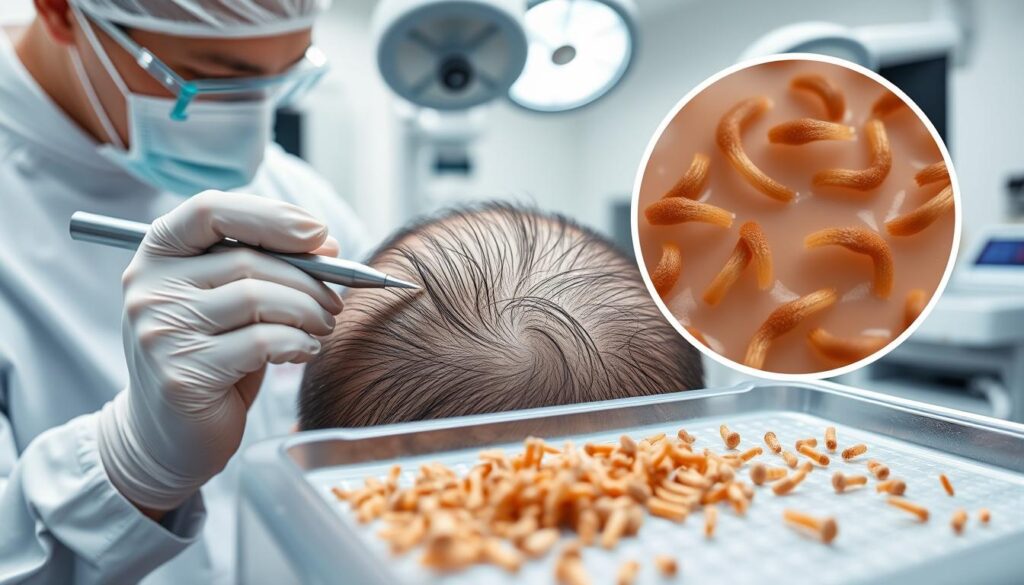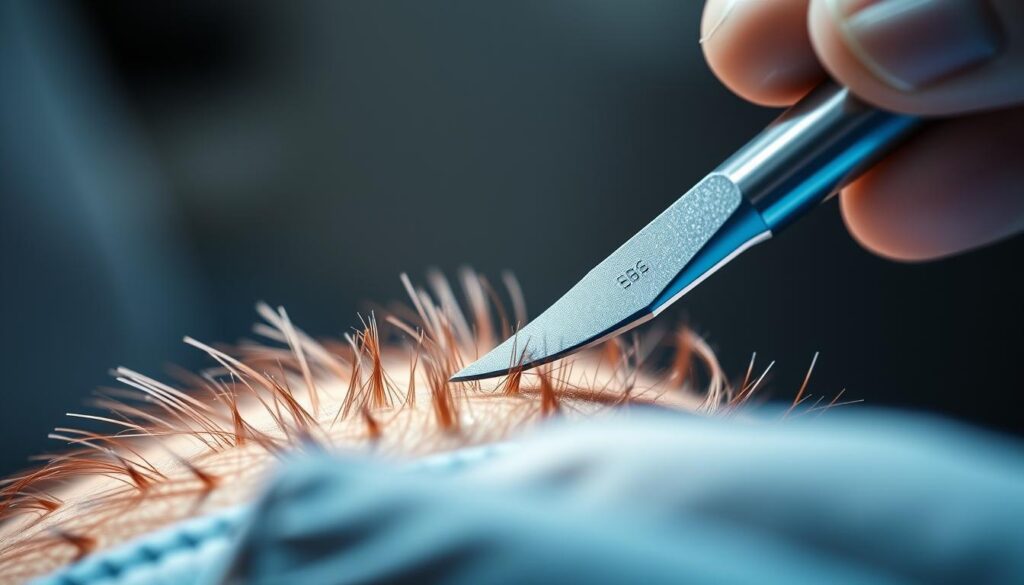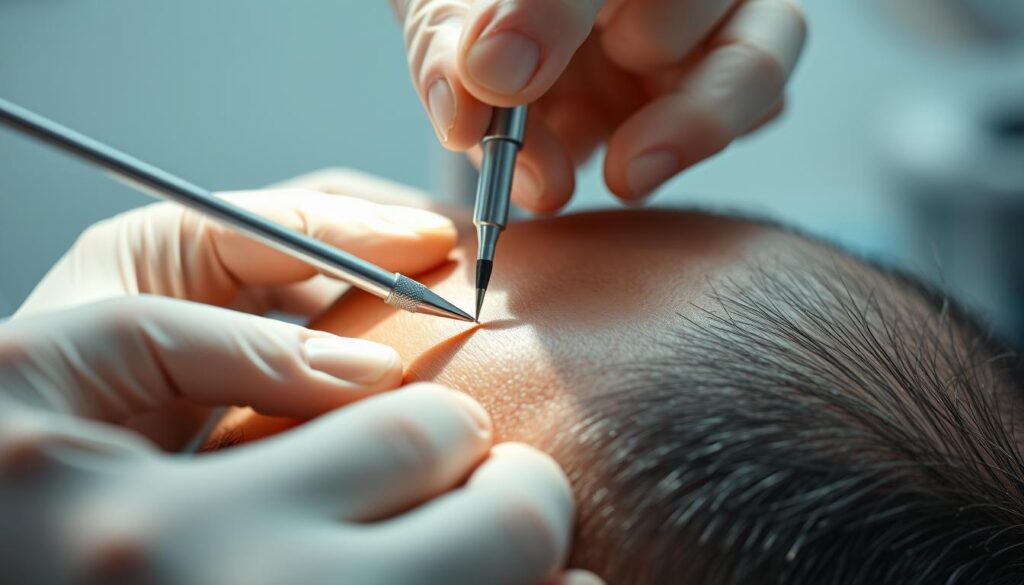Contents
Explore the latest hair transplant techniques for 2024, including FUE and advanced hair restoration methods, ensuring natural results and renewed confidence.
Did you know hair transplantation makes people very happy? By 2024, hair loss solutions have gotten better. Now, people with hair loss have hope again. New techniques like Follicular Unit Extraction (FUE), Sapphire FUE, and others are changing hair restoration.
Since the 1990s, hair transplant methods have changed a lot. Now, 2 out of 3 surgeries use FUE because it works better. New tech and methods add to FUE, making surgeries better and patients happier.
Now, we’re moving towards better, precise, and less invasive hair transplants. New tech and bio-enhancements help. They give patients natural looks, less scars, quick recovery, and better graft survival. The future of hair restoration looks bright in 2024.
Short Summary
- Hair transplantation has one of the highest patient satisfaction rates in plastic surgery
- FUE is the most common hair transplant technique as of 2024
- Innovations like Sapphire FUE, DHI, and robotic hair transplantation are advancing the field
- Bio-enhancements such as stem cell therapy improve graft survival and growth
- The industry is moving towards more precise, less invasive, and technologically advanced hair transplant techniques
Introduction to Hair Transplantation
Hair loss and receding hairlines are common issues for both men and women. They can make people look older and upset the balance of their face. Many look for ways to fix their hair and feel confident again. Modern hair transplant surgery has changed a lot, giving better and more natural results.

Understanding Hair Loss
Hair loss can happen for many reasons, like genes, hormones, health issues, and aging. Androgenetic alopecia, or male/female pattern baldness, is the most common type. It leads to thinning hair and a receding hairline or bald spots.
Studies show that many people suffer from hair loss:
- About 50% of men have hair loss by age 50
- 40% of women notice hair loss by age 50
- Genetics play a big part, making it more likely if family members have it
Brief History of Hair Transplantation
Dr. Norman Orentreich started exploring hair transplantation in the 1950s. He was a dermatology student at NYU. He found that hair follicles keep their traits even when moved to a new spot.
In 1952, Dr. Orentreich did the first modern hair transplant. He used “hair plugging,” punching out tissues full of hair and putting them in bald spots.
But, hair plugging didn’t look natural because the grafts were big. Later, new techniques like FUT and FUE came along. These methods gave more natural-looking results.
| Graft Type | Number of Hairs per Graft |
|---|---|
| Round-shaped punch grafts | 10-15 hairs |
| Mini-grafts | 2-4 hairs |
| Micro-grafts | 1-2 hairs |
| Slit grafts | 4-10 hairs |
| Strip grafts | 30-40 hairs |
Now, hair transplantation is a precise and personal process. It helps people restore their hair and boost their confidence.
Follicular Unit Transplantation (FUT) in 2024
Follicular Unit Transplantation (FUT), also known as the strip method, has been a trusted way to restore hair for many years. Even with new methods out there, FUT is still important in 2024. It gives certain patients unique benefits. This method takes a strip of skin from the back of the scalp. Then, it cuts it into individual follicular units for transplanting.

FUT is great because it can give a lot of follicular units. By taking a strip of skin, surgeons can get many grafts at once. This is very helpful for people who need a lot of grafts to cover their bald spots.
Advantages of FUT
FUT has many benefits for hair restoration. It lets surgeons put more grafts in at once than other methods like Follicular Unit Extraction (FUE). This is very useful for people with a lot of hair loss who need many grafts for a natural look.
Also, FUT grafts usually do better than FUE grafts. The strip method keeps the follicular units whole, which helps them grow better. This is great for people who don’t have much donor hair, as it uses every graft well.
Limitations of FUT
But, FUT has some downsides to think about. The main issue is the linear scar on the scalp after the strip is taken out. This scar can be hidden with long hair, but it might be a problem for those with short hair or who scar easily.
Another thing to consider is that FUT takes longer to recover from than FUE. The cut needs more time to heal, and patients might feel sore and need to rest. But, surgery has gotten better, and aftercare has too, making recovery easier for patients.
| Procedure | Duration | Graft Yield | Scarring |
|---|---|---|---|
| FUT | 4-12 hours | High | Linear scar |
| FUE | Up to 10 hours or more | Lower than FUT | Small, dot-like scars |
In conclusion, even though new hair transplant methods are popular, FUT is still a good choice in 2024. It’s great for giving many grafts and helping with big hair loss. When thinking about surgery, it’s smart to talk to a skilled surgeon. They can help decide if FUT is the best option for you.
Follicular Unit Extraction (FUE) in 2024
Follicular unit extraction (FUE) is changing hair transplantation. This method takes individual hair follicles from the donor area. It’s popular because it’s precise and leaves minimal scarring. By 2024, most hair restoration surgeries will use FUE, showing its leading role.

FUE’s success depends on the expertise of the surgeon. It’s different from old methods because it needs careful detail and skill. The surgeon uses small punches to take out follicles with 1-4 hairs each. This is done carefully to avoid hurting the donor area.
FUE doesn’t leave a big scar. People who get FUE can wear their hair short without seeing scars. Recovery is quick and not too painful, with scabs gone in 1-2 weeks.
“FUE has changed hair transplantation, giving patients a discreet and easy way to fight hair loss. The skill and care in this method have made our results much better.” – Dr. Michael Johnson, a top hair transplant surgeon
When done right by an expert, FUE is a lasting fix for hair loss. But, patients should know what to expect and check if they’re a good fit. The best candidates have stable hair loss, enough donor hair, and no surgery risks.
| Advantages of FUE | Considerations |
|---|---|
| Minimal to no linear scarring | Requires expertise and precision |
| Faster recovery time | Cost may vary based on surgeon’s experience |
| Less postoperative pain | Risk of overharvesting donor area |
| Ability to have shorter hairstyles | Minor side effects (e.g., scalp cysts, temporary shedding) |
Looking to 2024, FUE will keep leading in hair transplantation. With new tech and methods, FUE will get even better. This means patients will get results that look very natural and last a long time.
Sapphire FUE: Precision and Accuracy
In the world of hair transplantation, innovation is key. Sapphire FUE is a big step forward. It uses sapphire blades for placing transplanted follicles. This method has changed the game, offering unmatched precision and accuracy.

Benefits of Sapphire FUE
Sapphire FUE has many benefits. It uses sapphire blades for making tiny incisions. This means the hair looks very natural. Plus, healing is faster and scars are less noticeable.
Another big plus is how well the transplanted hair grows. The way it’s placed helps it grow better. This leads to great results for patients.
Sapphire FUE has changed hair transplants for the better. Its precision and accuracy are unmatched. Now, patients can get natural-looking hair with little downtime.
Improved Results and Recovery
Sapphire FUE has made hair transplants better in many ways. Patients see fuller, more natural hair faster. The small cuts mean fewer risks like infection or big scars.
| Aspect | Sapphire FUE | Traditional FUE |
|---|---|---|
| Incision Size | Smaller, more precise | Larger, less precise |
| Healing Time | Faster, less discomfort | Slower, more discomfort |
| Follicle Survival Rate | Higher, due to precise implantation | Lower, due to less precise implantation |
| Scarring | Minimal, virtually undetectable | More noticeable, larger scars |
The table shows sapphire FUE beats traditional FUE in many areas. It’s the top choice for those wanting great hair transplant results.
In conclusion, sapphire FUE is a big deal in hair transplantation. Its precision, accuracy, and results make it popular for achieving a full, natural look.
Direct Hair Implantation (DHI)
Direct Hair Implantation (DHI) is a new way to fix hair loss. It’s like Follicular Unit Extraction (FUE) but less invasive. It helps people get their hair back without the big scars from old methods.

Many people lose hair, over 85 percent of men and more than 50 percent of women by age 50. DHI is for those over 25 with thick hair and skin color close to their hair. It works best for those with thicker hair and similar skin and hair color.
The DHI Implanter Pen
The DHI implanter pen is key to DHI. It lets doctors place hair grafts exactly right, making it look natural. This pen also protects the new hair, helping it grow better than old ways.
There are two types of implanter pens, Choi and Lion. The choice depends on the doctor’s style and skill. Using dull pens means making holes first, then putting in grafts later.
Advantages of DHI
DHI doesn’t need cuts before the procedure. This means less scalp damage, faster healing, and a look that’s very natural. The implanter pens help the new hair grow better by reducing the time it spends outside the body.
DHI and FUE take about 8 hours and show results in 12 to 18 months. They don’t leave a long scar, making them great for short hair styles or hiding scars.
Limitations of DHI
DHI has its downsides. It takes longer than other methods, so you can’t do as many grafts at once. This means more sessions for big hair loss.
It’s also more expensive because two surgeons work together. A DHI session costs between $3,250 to $13,500 in places like London or Paris, based on how much hair you need.
| Factors | DHI | FUE |
|---|---|---|
| Precuts | No | Yes |
| Trauma to Scalp | Less | More |
| Graft Survival Rate | Higher | Lower |
| Implantation Time | Longer | Shorter |
| Grafts per Session | Limited | More |
| Cost | Higher | Lower |
Many clinics call it “Direct Hair Implantation,” but it’s not a specific method. The International Society of Hair Restoration Surgery says DHI is just a term. Always talk to a qualified doctor to find the best method for you.
Robotic Hair Transplantation: The Future is Now
Robotic hair transplantation is changing the game in hair restoration. It was first introduced by Dr. William Rassman and Dr. Robert Bernstein in 2007. This new tech uses robots for better results. The ARTAS Robotic System got the green light from the FDA in 2011. It’s now the top choice for robotic hair transplants.
ARTAS Robotic System
The ARTAS Robotic System has gotten better over the years. In 2018, the ARTAS iX came out, bringing new tech like machine learning and better arms for more precise work. This system picks up hair follicles automatically, making sure they’re just right. It also makes a 3D model of your scalp to plan the best results.
| Year | Milestone |
|---|---|
| 2008 | Introduction of the first ARTAS System by Restoration Robotics |
| 2011 | FDA approval of the ARTAS System for commercial use in the United States |
| 2018 | Launch of ARTAS iX, an advanced version with machine learning algorithms and improved robotic arms |
Benefits of Robotic Hair Transplantation
Robotic hair transplantation is better than old ways. The ARTAS system is super precise, which means less damage and faster healing. It also cuts down on mistakes, giving you better results. People who get this kind of transplant heal faster because it’s less invasive.
The ARTAS Robotic System has shown great results. Studies say:
- It cuts surgery time in half compared to old methods
- Hair grows back over 97% of the time thanks to the robot’s precision
- Almost all grafts stay whole during the surgery
- It can get up to 15% more hairs per harvest and 11.4% more per graft than old ways
The ARTAS Robotic System is the top choice for hair transplants around the world. Its tech lets grafts get put in faster and more accurately. This means hair looks natural and patients are happier. With new tech like artificial intelligence, the future of robotic hair transplantation looks bright.
Bio-Enhancements in Hair Restoration
In recent years, bio-enhancements have become a big deal in hair transplants. They aim to make hair transplants work better by using special products and substances found in our bodies. Let’s look at two big ones: PRP therapy and stem cell hair transplantation.
Platelet-Rich Plasma (PRP) Therapy
PRP therapy is getting popular in hair restoration. It takes a bit of the patient’s blood, makes it rich in platelets, and then injects it into the scalp. Platelets have growth factors that help hair follicles grow and heal the scalp.
Studies show PRP therapy is good for hair transplants. It helps grafts survive better, grows hair faster, and makes hair thicker. It also helps you heal quicker and feel less pain after the surgery.
Stem Cell Hair Transplantation
Stem cell hair transplantation is a new and exciting area. It’s still being tested but could change hair restoration a lot. Stem cells can turn into different cell types, including hair follicle cells.
For this method, stem cells are taken from the patient’s body. They are then put into the scalp to help grow new hair. Early results look good, but we need more studies to know for sure.
Bio-enhancements could really change hair restoration. Using PRP and stem cells, surgeons can offer better solutions for hair loss. As we learn more, I’m excited to see how these methods will improve hair transplants in the future.
| Bio-Enhancement Technique | Key Benefits |
|---|---|
| Platelet-Rich Plasma (PRP) Therapy |
|
| Stem Cell Hair Transplantation |
|
Latest Hair Transplant Techniques: A Comparison
Understanding the differences between hair transplant techniques is key. Each method has its own pros and cons. This helps patients pick the best one for their needs and goals. I’ll compare FUE vs. FUT, Sapphire FUE vs. Traditional FUE, and DHI vs. FUE to help you decide.
FUE vs. FUT
Follicular Unit Extraction (FUE) and Follicular Unit Transplantation (FUT) are top choices. FUE takes hair follicles from the back and moves them to the balding area. It’s less invasive, leaving no visible scars and healing quickly.
FUT removes a skin strip from the back, then cuts it into grafts. It can move more grafts at once but leaves a scar. This scar hides under hair over half an inch long.
| Characteristic | FUE | FUT |
|---|---|---|
| Procedure duration | 6-8 hours | 15-30 minutes |
| Scarring | Minimal, virtually undetectable | Linear scar, easily concealed with longer hair |
| Recovery time | 3-7 days | Longer than FUE |
| Cost | Generally more expensive than FUT | Considered the cheapest option among FUE, DHI, and FUT |
Sapphire FUE vs. Traditional FUE
Sapphire FUE is a new take on FUE. It uses sapphire blades for better precision. These blades make smaller cuts, helping the scalp heal faster and giving a more natural look.
DHI vs. FUE
Direct Hair Implantation (DHI) does both extraction and implantation in one step. It uses a special pen to put in the hair follicles right away. DHI is the most successful method and lets doctors control the hair’s angle and direction well. But, it takes longer and might not work for many grafts at once.
Talking to a skilled hair transplant surgeon is key to finding the right technique for you. Your hair loss, donor hair quality, and desired look will guide your choice.
Choosing the Right Hair Transplant Technique
Choosing the right hair transplant technique is key to a successful treatment. It’s important to think about your hair loss, donor hair quality, personal wishes, and budget. This choice can greatly affect your results.
It’s crucial to talk to a skilled hair restoration surgeon to find the best method for you. They will look at your hair loss, scalp, and health. They’ll talk about what you want, what you hope to achieve, and any risks or limits of each method.
Factors to Consider
When picking a hair transplant technique, think about these things:
- The extent and pattern of your hair loss
- The quality and quantity of your available donor hair
- Your age and potential for future hair loss
- Your desired hairline and density
- Your personal preferences and lifestyle
- Your budget for the procedure
Talk openly with your surgeon about these factors. This ensures your goals match the technique’s abilities. For example, if you have little donor hair, FUE might be better than FUT because it’s more precise.
Consultation with a Qualified Surgeon
Meeting with a skilled hair restoration surgeon helps pick the right technique for you. They’ll look at your medical history and hair loss. They’ll talk about what you want and what each technique offers.
A good surgeon listens to your worries, answers your questions, and gives advice tailored to you.
It’s important to feel at ease with your surgeon and trust they can give you natural-looking results. Look for a surgeon who is certified, has lots of hair restoration experience, and shows before-and-after photos. Reading reviews and asking for references can also help you understand their reputation and patient satisfaction.
The success of your hair transplant also depends on the surgeon’s skill and expertise. By choosing a qualified surgeon and the right technique, you increase your chances of getting the full, natural-looking hair you want.
Conclusion
Hair restoration has made big strides, and things are getting even better with new techniques. Now, we have Sapphire FUE and robotic hair transplantation. These changes are changing how we deal with hair loss.
Technology and skilled surgeons work together to give us results that look very natural. This was something we couldn’t dream of before.
But there’s more to come. Bio-enhancements like Platelet-Rich Plasma (PRP) therapy are making hair restoration better. They help with healing and make transplanted follicles grow faster. Hair cloning and stem cell research are still new but could change everything in the future.
Looking at the latest in hair transplant for 2024, I’m really excited. Whether you’re looking at FUE, DHI, or other options, now is a great time to act. You can take back your hair loss and feel confident again.
So, don’t wait. Meet with a qualified hair restoration surgeon today. Find the best solution for you. With the right method and a great team, you can get the full, natural-looking hair you’ve always wanted.
FAQ
What are the latest hair transplant techniques available in 2024?
In 2024, the newest hair transplant methods include Follicular Unit Extraction (FUE), Sapphire FUE, Direct Hair Implantation (DHI), robotic hair transplantation, and bio-enhancements. These are PRP therapy and stem cell hair transplantation.
What is the difference between FUE and FUT hair transplant methods?
FUE takes out individual hair follicles directly from the donor area. This leaves no or very little scar. FUT, however, takes a strip of tissue from the donor area. This leaves a linear scar and uses up more donor hair.
What are the benefits of Sapphire FUE compared to traditional FUE?
Sapphire FUE uses sapphire blades for making tiny, precise cuts during implantation. This leads to quicker healing, better graft survival, and results that look more natural.
How does Direct Hair Implantation (DHI) differ from FUE?
DHI uses a special pen to implant grafts without the need for blades or forceps. This gives more control over how the grafts are placed. It’s less damaging to the scalp and looks more natural. But, it takes longer and can’t do as many grafts at once.
What are the advantages of robotic hair transplantation?
Robotic hair transplantation, like the ARTAS Robotic System, automates the process of taking follicular units. It’s more efficient and precise. This lets surgeons focus on placing the grafts, leading to better results.
What are bio-enhancements in hair restoration, and how do they work?
Bio-enhancements like PRP therapy and stem cell hair transplantation help grafts survive and grow better. PRP has growth factors that help healing and hair growth. Stem cell therapy uses stem cells to make new hair follicles, possibly making hair thicker.
How do I choose the right hair transplant technique for my needs?
The right technique depends on how much hair you’ve lost, the quality of your donor hair, what you prefer, and your budget. Talking to a skilled hair restoration surgeon is key to finding the best method for you.
What can I expect during a consultation with a hair restoration surgeon?
The surgeon will look at your hair loss, scalp, and health to suggest the best option. They’ll talk about what you want, what results you can expect, and any risks or limits of each method. This helps you make a well-informed choice.
